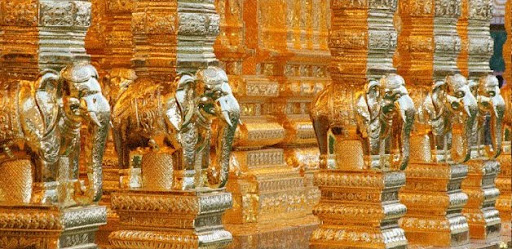
The dome that encloses the Dhyanalinga is a section of an ellipse - like a section of the globe. The technical aspects involved in the making of the dome are very interesting and its construction, an epic by itself.
It was Sadhguru's wish that all the visitors to the temple be allowed directly into the garbhagriha or the sanctum sanctorum. As a result, the garbhagriha had to have a very large free spanning structure. Conventional buildings built of cement, steel and concrete were ruled out, as the life span of such structures is not expected to be beyond a hundred years. Eventually, it was decided to build a dome using only traditional materials like burnt bricks, mud mortar stabilized with lime, sand, alum and some herbal additives. Huge blocks of granite were extensively used, eliminating steel and concrete.
The dome, weighing about 700 tons, measures 33 ft from the ground level and has a diameter of 76 ft at the bottom. Approximately 250,000 bricks were used in making this dome, each of which had to be measured to the millimeter. The first course of brick starts at 13 degrees to the horizontal and the last course ends at an almost vertical angle of 82 degrees to the horizontal. The base of the dome is 20" thick and tapers off to 8" - the thickness of a single brick at the top.
The dome rests on a circular stone masonry wall 6 ft high including a ring of stone lintels 2 feet tall. This entire structure is built upon a foundation that is 10 ft wide and 10 ft deep. The main entrance to the dome is in the form of a stone vault 9 ft 6 inches wide and 8 ft tall. Twenty-eight ventilators are placed on the top of the lintel beams with stone slabs arranged in the shape of the triangle. These triangular stone ventilators at the base of the Dome provide light and ventilation. The central opening is covered by a gold plated Linga-shaped copper dome, which blocks direct light and acts as a ventilator at the top. The copper Linga above the dome vents out hot air from the dome so that the cool air passes in through the vault and ventilators.

Below the lintel beam, twenty-eight energy cubicles called the 'aura cells' are embedded in the inner wall. Each 'aura cell' is approximately 4' x 4' and provides an intimate space for a person to sit and meditate facing the Dhyanalinga.
Since it was the first time ever that such a large structure was being raised without any form-work, ring-beams, steel or concrete, each aspect of the building had to be worked out afresh, researching and experimenting to derive a safe, viable and feasible methodology for each of the aspects. This often amounted to an interesting blend of ancient and locally available material and techniques.
Burnt bricks were placed in the elliptical shaped dome in positions determined precisely by modern mathematics and verified by computer calculations, granite slabs from traditional quarries went through modern gang saws for precise fitting. For the eighteen months it took to complete the temple from the foundation, the usually quiet and serene surroundings had been transformed into, among other things, a brick kiln and a granite quarry. For the eight weeks it took to construct the dome as such, it resembled a large anthill - hundreds of people going up and down, gradually accomplishing a mission much larger in size and importance than themselves.

The entire structure is a vision of Sadhguru Jaggi Vasudev. The entire design was conceived by Sadhguru and executed by Bhramhachari engineers with the help of about 300 local unskilled laborers. Throughout the duration of the construction, a steady stream of dedicated volunteers participated in the construction in large numbers, taking time off from their work and family to participate in the making of this offering.





























